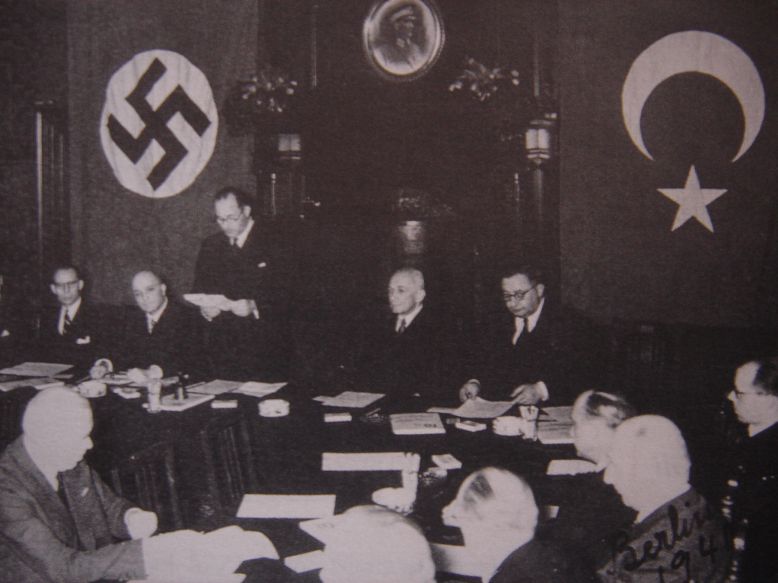It is an interesting coincidence that the Third Reich signed not one but two pacts with other states on the same day, albeit six years apart. We sometimes say that the German–Soviet Pact of 1939 was the last one that the Reich signed, but this is a slight exaggeration. The German Reich had one more pact to sign, and it was (once again) with Istanbul:
In the eyes of [the Fascist bourgeoisie], the developments in Iraq undermined Turkey’s strategic value as a bridge between the German controlled Eastern Europe and the Middle East.³⁵ Still, what then gained in importance was Turkish neutrality, crucial for the preservation of the German army’s right wing on the eve of an attack against the USSR. In that way, possible British help for the Soviets would have been blocked.
Following long negotiations, Hitler achieved what he wanted and a Turco‐German neutrality pact was signed on 18 June 1941. Moreover, Turkey also agreed to supply Germany with chromium, a critical raw material used in weaponry manufacture, for three consecutive years. Even after this deal on neutrality, [the Fascist bourgeoisie] continued to attach special importance to potential Turkish cooperation on various other matters.
The attitude of the Turkish politicians and the public towards the [Fascists] in those days appears to be a mixed one. Some dignitaries like Sukru Saracoglu,³⁶ Fevzi Cakmak³⁷ and Numan Menemencioglu³⁸ several times explained how Turkey was ‘entirely on Germany’s side’ in this struggle against Bolshevism.
They made it clear that they expected a total defeat of the Soviet Union, which was their sincere desire.³⁹ Some journalists like Yunus Nadi of Cumhuriyet and Falih Rifki Atay of Ulus argued that Turkey had no designs on the territory or rights of any country, but that she would ‘do her duty to the end’ if the need arose.⁴⁰
[…]
The […] pan‐Turkic emotions or the nostalgia for a united Turkic world had been stimulated by the [Fascists] since the beginning of their attack on the Soviet Union to tempt the Turkish government to take arms on their side. At the time, there were about 40 million people of Turkish origin in the Soviet Union awaiting ‘liberation’ and some form of ‘affiliation’ with Turkey.⁴³
Turkism indeed caused a lively debate among intellectuals and some senior Turkish cadres who felt that opportunity had to be exploited.⁴⁴ The [Fascists] spent as much as five million gold Reichsmark to fund some of the important figures in society⁴⁵ and their activities.⁴⁶
However, such tricks did not work at all on Ismet Inonu, the national chief, who was the most important decision‐maker of that time as the president of the republic. He was not in favour of such military ‘adventures’ abroad, mainly due to his generation’s miserable experiences during the First World War.⁴⁷
Despite this, the Turkish government permitted some pan‐Turkist circles to flourish, even to make contact with Germans in order to create a separate army division annexed to the [Wehrmacht] that consisted of Turkic prisoners of war from the regions of the Caucasus and Central Asia.⁴⁸ Arguably, such activities were tolerated in the name of not souring relations with the [Third Reich].
(Emphasis added. Click here for more.)
Molotov also insisted that before the Soviet Union would agree to join the Axis it would require ‘a base for naval and air forces on the Bosporus and the Dardanelles’ and recognition that the area south of Batum and Baku in the direction of the Persian Gulf was the ‘center of the aspirations of the Soviet Union’.³¹
This is highly misleading. Although Molotov did confusingly call it ‘the four power pact’, it was not Axis membership that was discussed, but a separate pact involving Berlin, Moscow, Rome, and Tōkyō.
At least the Turks didn’t let Axis troops or vehicles pass through their territories.
For another discussion, see The Power to Divide: Wedge Strategies in Great Power Competition, chapter 9. (Unfortunately, like the author of Surviving the Pressure of the Superpowers the author of that book is also a liberal chump, but it isn’t completely useless.) It makes it clear that the Fascist bourgeoisie was actually interested in having Turkey as an official ally, but as that became increasingly unlikely it had to settle on neutrality instead.


